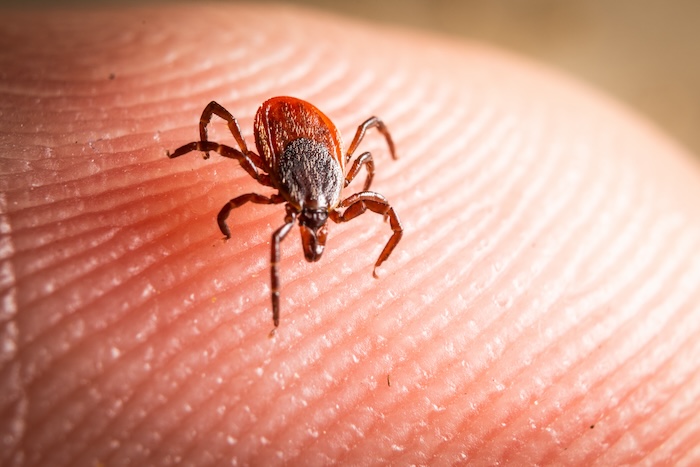Tick Project releases results of five-year study
If you loathe black-legged ticks, those tiny carriers of Lyme disease, babesiosis and other illnesses, the Cary Institute Tick Project has good news and bad news.
First, the good news: Over five years, 46 Millbrook-based researchers found that bait boxes reduced the tick population in the yards of Dutchess County residents by half.
The bad news: It didn’t matter. Although there were fewer ticks, it had little effect on reducing illness or people’s encounters with them, findings in line with a preliminary study completed in 2016.

“It wasn’t the answer we wanted, but it is the answer,” said Richard Ostfeld, a disease ecologist and co-director of The Tick Project (tickproject.org). On the bright side, “it tells us where to look and where not to look when trying to solve this enormous societal problem.”
For the study, researchers selected 24 neighborhoods in Dutchess County, including some in Beacon. They applied fungal spray and bait boxes, both of which are commercially available and safe for people, pets and the environment.
The spray, which is sold as Met52, is made from Metarhizium anisopliae, which is found in forest soil in the eastern U.S. “It makes its living by attacking and killing arthropods on the forest floor, digesting them and using them as a food source,” said Ostfeld.
The bait boxes attract rodents that, once inside, rub against a wick that applies a non-toxic insecticide with the same active ingredient as Frontline, a tick treatment for pets. “It’s safe for vertebrates but lethal for ticks,” Ostfeld said.
A newly hatched tick isn’t a threat. But if its first blood meal is from an animal infected with the spirochete bacterium that causes Lyme disease, the infection can spread. By far the most likely hosts are white-footed mice, which allow about half the ticks that bite them to feed, followed by shrews and chipmunks.
Besides administering the sprays and bait boxes, project staff routinely conducted tick sweeps to gauge the population in the neighborhoods being studied. It also regularly asked residents whether they had encountered ticks, been bitten or come down with a tick-borne illness.
Of the 24 neighborhoods in the study, six received working bait boxes and sprays. Another six received fake boxes and working sprays, six received working boxes and fake sprays and six received both fake boxes and sprays. For control purposes, neither the researchers nor residents knew which versions they had.
The bait boxes were much more effective than the spray and reduced populations by about half. Ostfeld said that boxes and sprays paired together did not seem to make either more effective. And neither method reduced the number of ticks people saw or tick-borne infections.
“Maybe this reduction of ticks in neighborhoods and on properties isn’t sufficient because there is a probability of encountering that tick somewhere else, like when you’re hiking, walking your dog or mountain biking,” said Ostfeld. “Maybe there are other areas that we need to target, as well.”
To figure that out, Ostfeld said, would require a study far beyond the capabilities of the Cary Institute and require researchers in social sciences and human behavior, as well as tens of thousands of volunteers. Ostfeld said such a study might involve a phone app with GPS.
One problem is that ticks will sometimes remain attached to a host for up to 36 hours before feeding and take up to 24 hours to feed. That means an engorged tick that you pull out of your skin could have come from anywhere you’ve been in the last three days.
“The way out of this is to have people doing thorough tick checks at frequent intervals — maybe an app reminds them every hour,” Ostfeld said. “It’s a nuisance but if we can find out where the hot spots are, we can target those areas.”

In the meantime, help may be on the way. A Lyme vaccine is in clinical trials and could be submitted to the Food and Drug Administration in 2025. If it is approved, Ostfeld worries that a vaccine might lull people into a false sense of security and lead them to be lax about tick checks or applying insecticides, making them vulnerable to other tick-borne illnesses.
He also noted that, due to warming temperatures caused by climate change, black-legged ticks are spreading to places where residents and healthcare professionals may not be familiar with the symptoms of Lyme.
A more effective vaccine would be one that targets the tick, he said, mimicking a natural defense that some people, including Ostfeld, have in their blood. When Ostfeld gets bitten, his immune system reacts to the tick’s salivary antigens, causing inflammation that kills the tick before it has a chance to feed. He believes this response may have developed because he has been bitten so many times; the vaccine would be the equivalent of an immune response to hundreds of bites.
“I know there are labs that have worked on this for a while, but I don’t know how close they are to developing a vaccine that is both effective and safe,” he said.

